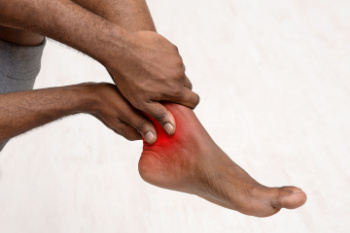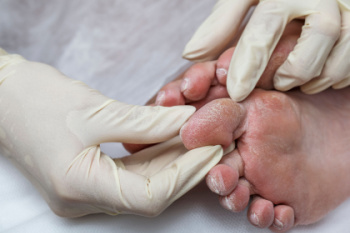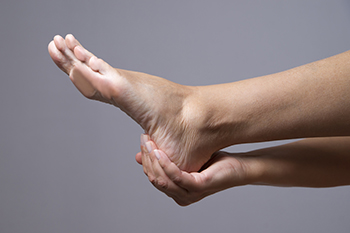Items filtered by date: April 2024
Early Indications of Rheumatoid Arthritis and Its Impact on the Feet

Rheumatoid arthritis, or RA, manifests through subtle yet telling signs, especially in its early stages. A common indicator is persistent joint stiffness, particularly in the mornings or after periods of inactivity. Accompanying this stiffness is often joint pain and swelling, which can gradually worsen over time. RA does not discriminate, affecting various joints throughout the body, including those in the feet. In fact, the feet are commonly among the first areas affected by RA. The condition can lead to inflammation in the joints of the feet, causing pain, swelling, and difficulty with mobility. Over time, RA may cause deformities such as bunions, hammertoes, or joint collapse in severe cases. If you are experiencing any of the above symptoms in your feet, it is strongly suggested that you are under the care of a podiatrist who can offer you effective management strategies.
Because RA affects more than just your joints, including the joints in your feet and ankles, it is important to seek early diagnosis from your podiatrist if you feel like the pain in your feet might be caused by RA. For more information, contact Dr. Ronald Sheppard of Warren-Watchung Podiatry Center. Our doctor will assist you with all of your podiatric concerns.
What Is Rheumatoid Arthritis?
Rheumatoid Arthritis (RA) is an autoimmune disorder in which the body’s own immune system attacks the membranes surrounding the joints. Inflammation of the lining and eventually the destruction of the joint’s cartilage and bone occur, causing severe pain and immobility.
Rheumatoid Arthritis of the Feet
Although RA usually attacks multiple bones and joints throughout the entire body, almost 90 percent of cases result in pain in the foot or ankle area.
Symptoms
- Swelling and pain in the feet
- Stiffness in the feet
- Pain on the ball or sole of feet
- Joint shift and deformation
Diagnosis
Quick diagnosis of RA in the feet is important so that the podiatrist can treat the area effectively. Your doctor will ask you about your medical history, occupation, and lifestyle to determine the origin of the condition. Rheumatoid Factor tests help to determine if someone is affected by the disease.
If you have any questions please feel free to contact one of our offices located in Marlboro and Watchung, NJ . We offer the newest diagnostic and treatment technologies for all your foot and ankle needs.
Foot Pain From Standing at Work
 Prolonged standing or walking at work can put excessive strain on the feet and lower limbs and lead to foot pain. Various foot conditions can arise from this, including plantar fasciitis, heel pain, or arch pain. Improper footwear or not taking regular breaks can make these issues worse. Podiatrists, or foot doctors, can diagnose and treat foot pain caused by these occupational factors. They can provide personalized recommendations tailored to your specific needs, including advice on proper footwear and stretching exercises to alleviate discomfort. Podiatrists may also offer custom orthotic devices to provide support and cushioning, reducing the strain on your feet and improving overall comfort. People who work on their feet don’t have to suffer. It is possible to find relief from pain, work more efficiently, and preserve overall foot health. If you are experiencing foot pain due to work or standing all day, make an appointment with a podiatrist to discuss your options.
Prolonged standing or walking at work can put excessive strain on the feet and lower limbs and lead to foot pain. Various foot conditions can arise from this, including plantar fasciitis, heel pain, or arch pain. Improper footwear or not taking regular breaks can make these issues worse. Podiatrists, or foot doctors, can diagnose and treat foot pain caused by these occupational factors. They can provide personalized recommendations tailored to your specific needs, including advice on proper footwear and stretching exercises to alleviate discomfort. Podiatrists may also offer custom orthotic devices to provide support and cushioning, reducing the strain on your feet and improving overall comfort. People who work on their feet don’t have to suffer. It is possible to find relief from pain, work more efficiently, and preserve overall foot health. If you are experiencing foot pain due to work or standing all day, make an appointment with a podiatrist to discuss your options.
While working on the feet, it is important to take the proper care of them. For more information about working on your feet, contact Dr. Ronald Sheppard from Warren-Watchung Podiatry Center. Our doctor will treat your foot and ankle needs.
Working on Your Feet
Standing on your feet for long periods of time can cause stress and pain in your feet. Your whole body may experience change in terms of posture, back pain, bunions, callouses and or plantar warts. There are ways to avoid these conditions with proper foot care, smart choices and correct posture.
Positive Changes
Negative heeled shoe – Choosing this shoe type places the heel slightly lower than the ball of the foot. These are great for overall foot health. Find shoes that fit you correctly.
Go barefoot – Our feet were not designed to be enclosed for all hours of the day. Try to periodically expose your feet to air.
Eliminate Pain
Foot Exercises – Performing simple exercises, incorporating yoga and doing stretches are beneficial. This will allow increased blood flow to the area and muscles of the foot.
Achilles tendon – Stretching the foot out flat on the floor will relax the calf muscles and tendon. These exercises can be performed almost anywhere. Make sure you add these exercises to your daily regimen.
With a little bit of this information and knowing more about foot health, you will notice changes. Foot stretches and proper footwear will help with pain and prevent further issues.
If you have any questions please feel free to contact one of our offices located in Marlboro and Watchung, NJ . We offer the newest diagnostic and treatment technologies for all your foot and ankle needs.
The Need for Diabetic Patients to See a Podiatrist

Diabetic patients require special attention to foot health due to their increased risk of developing complications such as neuropathy, poor circulation, and foot ulcers. Neglecting foot care can lead to serious consequences like infections, foot deformities, and even amputation. To maintain optimal foot health, people who are diabetic should adhere to a few simple tips. First, inspect the feet daily for cuts, sores, or blisters, as early detection is crucial. Second, wash and dry the feet thoroughly, paying attention to the spaces between the toes. Moisturize regularly, but avoid applying lotion between toes to prevent fungal infections. Additionally, wear comfortable, well-fitting shoes and never walk barefoot, even indoors. Regular exercise improves circulation, benefiting foot health. Most importantly, if you have diabetes, it is strongly suggested that you schedule regular check-ups with a podiatrist who can monitor foot health and promptly address any concerns.
Diabetic foot care is important in preventing foot ailments such as ulcers. If you are suffering from diabetes or have any other concerns about your feet, contact Dr. Ronald Sheppard from Warren-Watchung Podiatry Center. Our doctor can provide the care you need to keep you pain-free and on your feet.
Diabetic Foot Care
Diabetes affects millions of people every year. The condition can damage blood vessels in many parts of the body, especially the feet. Because of this, taking care of your feet is essential if you have diabetes, and having a podiatrist help monitor your foot health is highly recommended.
The Importance of Caring for Your Feet
- Routinely inspect your feet for bruises or sores.
- Wear socks that fit your feet comfortably.
- Wear comfortable shoes that provide adequate support.
Patients with diabetes should have their doctor monitor their blood levels, as blood sugar levels play such a huge role in diabetic care. Monitoring these levels on a regular basis is highly advised.
It is always best to inform your healthcare professional of any concerns you may have regarding your feet, especially for diabetic patients. Early treatment and routine foot examinations are keys to maintaining proper health, especially because severe complications can arise if proper treatment is not applied.
If you have any questions please feel free to contact one of our offices located in Marlboro and Watchung, NJ . We offer the newest diagnostic and treatment technologies for all your foot and ankle needs.
Do Your Child's Feet Hurt?
How a Plantar Fibroma Is Diagnosed
 Plantar fibroma is a condition where a benign lump forms within the plantar fascia, the band of tissue that runs along the bottom of the foot. This lump is made up of connective tissue and is usually located in the arch of the foot. It can cause discomfort or pain as pressure is applied to the area, especially when standing or walking. Diagnosing a plantar fibroma typically involves a physical examination from a podiatrist, or foot doctor. The podiatrist may feel the lump in the foot's arch and might confirm the diagnosis through imaging tests, such as ultrasound or MRI. These tests help to visualize the fibroma's size and exact location within the plantar fascia to ensure it is not something else. Early diagnosis and treatment are important to manage symptoms and prevent the fibroma from worsening. If you have a lump in the arch of the foot, it is suggested that you promptly schedule an appointment with a podiatrist for diagnosis.
Plantar fibroma is a condition where a benign lump forms within the plantar fascia, the band of tissue that runs along the bottom of the foot. This lump is made up of connective tissue and is usually located in the arch of the foot. It can cause discomfort or pain as pressure is applied to the area, especially when standing or walking. Diagnosing a plantar fibroma typically involves a physical examination from a podiatrist, or foot doctor. The podiatrist may feel the lump in the foot's arch and might confirm the diagnosis through imaging tests, such as ultrasound or MRI. These tests help to visualize the fibroma's size and exact location within the plantar fascia to ensure it is not something else. Early diagnosis and treatment are important to manage symptoms and prevent the fibroma from worsening. If you have a lump in the arch of the foot, it is suggested that you promptly schedule an appointment with a podiatrist for diagnosis.
A plantar fibroma may disrupt your daily activities. If you have any concerns, contact Dr. Ronald Sheppard of Warren-Watchung Podiatry Center. Our doctor can provide the care you need to keep you pain-free and on your feet.
Plantar Fibroma
A plantar fibroma is a fibrous knot in the arch of the foot. It is embedded in the plantar fascia which is a band of tissue that extends from the heel to the toes along the bottom of the foot. There can be multiple plantar fibromas in the feet at the same time. There are no known causes for this condition. If you have a plantar fibroma, there will be a bump in the arch of your foot that cannot be missed. Any associated pain is most often due to a shoe rubbing against the nodule. Non-surgical options, such as steroid injections, physical therapy, and orthotics should be tried first. Surgery is a last resort and is the only thing that will remove a plantar fibroma entirely. Consult with a podiatrist for a proper diagnosis and to determine the treatment regimen that is right for you.
What Causes a Plantar Fibroma?
While there are no specific causes identified, a plantar fibroma can possibly come from genetic predisposition or the formation of scar tissue that forms from healing the tears in the plantar fascia.
What Are the Symptoms of a Plantar Fibroma?
There will be a noticeable lump in the arch of the foot that may or may not cause pain. If pain is felt, it is typically because a shoe is rubbing up against the lump or when walking or standing barefoot.
Treatment and Prevention
A plantar fibroma will not disappear without treatment, but it can get smaller and be a non-issue. If pain persists, a podiatrist examines the foot and when the arch of the foot is pressed, pain can be felt down to the toes. An MRI or biopsy might be performed to help diagnose or evaluate the plantar fibroma. The following non-surgical options are generally enough to reduce the size and pain of these nodules:
- Steroid injections
- Orthotics
- Physical therapy to help apply anti-inflammatory creams on the bump
Surgery is considered if the mass increases in size and the patient continues to feel pain after non-surgical methods are tried.
If you have any questions please feel free to contact one of our offices located in Marlboro and Watchung, NJ . We offer the newest diagnostic tools and technology to treat your foot and ankle needs.
Problems From Wearing High Heels

Wearing high heels can lead to a variety of discomforts and health issues. Continuous friction and pressure from ill-fitting shoes can cause blisters, corns, and calluses. Moreover, the unnatural foot position in high heels can contribute to ankle sprains, stress fractures in the foot or ankle bones, and even long-term problems like arthritis. The altered posture and gait induced by high heels can lead to pain in the knees, hips, and lower back. Additionally, the pressure on the toes can result in deformities like hammertoes or ingrown toenails. A podiatrist can provide valuable assistance in managing these issues. They can offer advice on proper footwear selection and fitting, as well as prescribe custom-made orthotic inserts to alleviate pressure points and improve foot mechanics. Podiatrists can also treat existing foot problems such as blisters, corns, and ingrown toenails, and provide guidance on stretching and strengthening exercises to mitigate the impact of high heels on foot health. If you wear high heels and are experiencing foot pain or any other foot problems, it is suggested that you make an appointment with a podiatrist for care.
High heels have a history of causing foot and ankle problems. If you have any concerns about your feet or ankles, contact Dr. Ronald Sheppard from Warren-Watchung Podiatry Center. Our doctor can provide the care you need to keep you pain-free and on your feet.
Effects of High Heels on the Feet
High heels are popular shoes among women because of their many styles and societal appeal. Despite this, high heels can still cause many health problems if worn too frequently.
Which Parts of My Body Will Be Affected by High Heels?
- Ankle Joints
- Achilles Tendon – May shorten and stiffen with prolonged wear
- Balls of the Feet
- Knees – Heels cause the knees to bend constantly, creating stress on them
- Back – They decrease the spine’s ability to absorb shock, which may lead to back pain. The vertebrae of the lower back may compress.
What Kinds of Foot Problems Can Develop from Wearing High Heels?
- Corns
- Calluses
- Hammertoe
- Bunions
- Morton’s Neuroma
- Plantar Fasciitis
How Can I Still Wear High Heels and Maintain Foot Health?
If you want to wear high heeled shoes, make sure that you are not wearing them every day, as this will help prevent long term physical problems. Try wearing thicker heels as opposed to stilettos to distribute weight more evenly across the feet. Always make sure you are wearing the proper shoes for the right occasion, such as sneakers for exercising. If you walk to work, try carrying your heels with you and changing into them once you arrive at work. Adding inserts to your heels can help cushion your feet and absorb shock. Full foot inserts or metatarsal pads are available.
If you have any questions please feel free to contact one of our offices located in Marlboro and Watchung, NJ . We offer the newest diagnostic and treatment technologies for all your foot and ankle needs.

